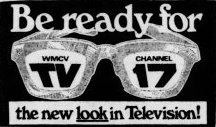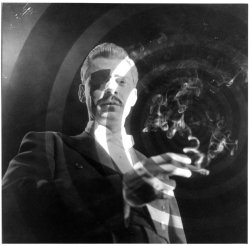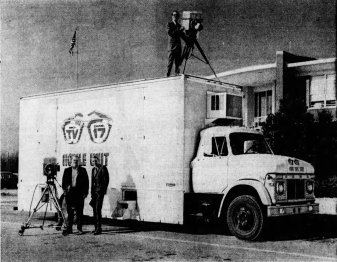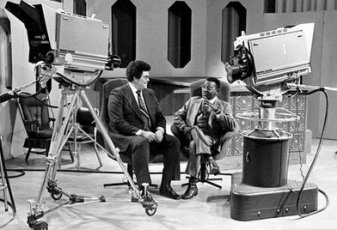by K.M. Richards
WMCV -- the call letters stood for owners Music City Video, Inc. -- first applied for channel 24 in Nashville on February 3, 1966 (the channel was changed one month later when the FCC amended the allocation table) and received its construction permit a mere three days after the 190th birthday of our nation, on July 7, 1966. A second UHF, WKTO-TV/30, was granted a CP less than a month later, on August 2, but its permit was twice cancelled for failure to begin construction before being surrendered two months after its second reinstatement in 1971.

Channel 17 went on the air a little over two years later on August 5, 1968 with a 3:00pm to midnight schedule that included movies at sign-on, a double feature at 7:00pm, and a late movie at 10:30pm. In between, WMCV offered local programs Matty's Fun Club and Seventeen Time from 4:30 to 6:00 and syndicated fare such as Bat Masterson, Western Star Theatre and Peter Gunn.
They also resurrected "Dr. Lucifur's Mystic Circle", a hosted Saturday night horror movie, which had been a constant on crosstown WSIX-TV/8's schedule for nearly a decade, from the summer of 1959 until the spring of 1967; "Lucifur" was radio announcer Ken Bramming, who reprised the role on WMCV for a little over a year, until November 1969.

Ken Bramming as Saturday night
horror movie host "Dr. Lucifur". |
For Dr. Lucifur, Bramming mixed a bit of Bela Lugosi with John Carradine and Vincent Price at their most charming. He created a dapper, silver-haired, suave Transylvanian host dressed in white tie and a black tuxedo, with a black eyepatch and an obvious affection for fine tobacco. A filmed black-and-white intro and outro would run each week with the movie, and the breaks during the actual film would be performed live in the studio. Dr. Lucifur would rarely be seen during the live portions. Instead, the show was shot "subjectively" from his viewpoint as he interacted with a supporting cast of ne'er-do-wells, including "Granny Gruesome", "Frantic Freddy the Hipster" and "Baron Von Sloucho". The skits that Bramming and his compatriots performed rarely had anything to do with the night's feature. They ranged from spoofs on current events to parodies of popular TV shows of the day.
In November, WMCV announced same-day delayed telecasts of Friday evening high school basketball matches, which involved the use of their mobile unit, which was nicknamed the Jolly Green Giant because of its size (32 feet long by 8 feet wide and 12 feet tall) and bright green color. The Giant had both microwave and videotape capability and was also used for Sunday morning remotes from the Woodmont Baptist Church. Not wanting to miss a revenue opportunity, the unit was also rented out on occasion to other stations within a 500-mile radius and to educational and industrial organizations "for closed-circuit application".
Other programming firsts claimed by WMCV in its early years included live in-studio wrestling (with a live studio audience!) on Saturday nights; a Sunday afternoon series Your Legal Rights, in which criminal court Judge Charles Galbreth and other panel members answered viewer questions about the law; stock car races from the Nashville Fairground Speedway; a tape-delayed broadcast of the annual "Our Little Miss" Nashville pageant; and, in a predecessor to the Nashville Network's Nashville Now program of the 1980s and 1990s, a weekly interview and performance show titled Holliday Country, the title being a nod to host Doc Holliday of Nashville

WMCV's "Jolly Green Giant". On the roof is cameraman William Bell;
standing next to the truck are Ed Savely of the production staff and
production director Ed Walker. Photo courtesy The Tennessean. |
suburban radio station WENO/1430. At the time of the show's debut in August 1969, WMCV called the new program "an effort to draw the city of Nashville and the music industry together", claiming neither had really understood each other up until then. Billboard magazine reported that the show featured "filmed or taped visits" of Music Row, as well as live performances of current releases and a weekly salute to one of the major record labels and its artists.
As time went on, WMCV pioneered all-night movie telecasts, and at one point in 1970 was said to have set a local television record for the most movies aired in a single week (26, according to The Tennessean newspaper).
In the summer of 1970, WMCV nearly prevented ABC from including the annual Nashville 420 auto race -- part of NASCAR's Grand National series -- in the network's Wide World of Sports program, claiming it had exclusive video rights to Fairground Speedways races; it obtained an injunction the afternoon before the July 25 race on that basis, but the telecast went on as scheduled and on the following Monday The Tennessean quoted Speedways' owner Bill Donoho as saying they had only an oral agreement with channel 17 to carry only races that took place at night "and letting ABC have this one." No one at WMCV was available for comment and no hearing was ever reported being held on the matter.
A handful of additional syndicated offerings were added in 1969-70, including off-network reruns of Topper (starring Leo G. Carroll, who by then was better known as Mr. Waverly on The Man From U.N.C.L.E., as the title character), The Munsters, Run For Your Life, Mark Saber, My Favorite Martian and I Spy. In addition, the 39 episodes of 1957's U.K.-produced syndicated series White Hunter, which had been airing on Saturday evenings since WMCV's first week on the air, became incessant as they had begun airing nightly by early 1969.
Although all of this might have made it appear to viewers that channel 17 was doing just fine, in reality that was not the case. On March 10, 1971 the Music City Video board of directors made the decision to suspend broadcasting after the following weekend "for a period not to exceed approximately 90 days", according to general manager Ed Sheppard. He went on to tell The Tennessean that negotations had been underway for several weeks to merge the station into an existing corporation of prominent Nashvillians, and that "plans for major program and format changes" would be undertaken afterwards.
WMCV went dark March 14, 1971 and filed for bankruptcy not long afterwards. In the interim, it was revealed that channel 17 had a direct connection to the U.S. government in that Rep. Richard H. Fulton owned 6.7% of the voting common shares of Music City Video, although this did not become common knowledge until a Broadcasting article on station ownership by Congressmen and their families was published in May 1971. One year later, Fulton was reported as having divested his interest in WMCV, no doubt as a result of the bankruptcy. Meanwhile, channel 17's STA to "remain silent" was painfully extended, thirteen times, for only a few months each time.

Hudson Broadcasting executive vice president Jim Lawson and
president Robert Hudson in the old WMCV studios shortly after
taking possession of same in the bankruptcy hearings. |
A black-owned company, Hudson Broadcasting, paid $60,000 at the bankruptcy proceeding for WMCV's physical assets and license, the transfer of which was approved by the FCC on July 31, 1974. At the time, president Robert D. Hudson, Jr. said his firm "would be prepared to put the station on the air within 90 days of Commission approval" and promptly changed the call letters to WTLT (for "Total Local Television"), unveiling a new station logo which was based on the red, black and green Pan-African flag designed in 1920 by Marcus Garvey of the United Negro Improvement Association which was coming into more widespread use in the 1970s. An article in The Tennessean quoted WTLT director of operations Bill Perkins as saying WMCV's "problem" was that their programming had "no facet" to it and that the new management would be "about 60% black-oriented" to correct that, including children's programming to counteract -- in Perkins' words -- "this negative Superfly image Hollywood puts out".
They never got the chance. After doing little more than constructing a new studio building on real estate owned by one of their principals, channel 17's license was sold to Reel Broadcasting on September 30, 1975; the price was the assumption of $42,500 in debts and the execution of a lease agreement for the new studio building. A waiver of the FCC's "three-year rule", which at the time specified the minimum length of time a station had to be owned by a party before selling it, had to be applied for because Hudson "lacked the funds to put the station back on the air". (The STA had been extended two more times while Hudson had held the license.)
Reel changed the call letters again (to WZTV, the calls the station still holds) in December and returned channel 17 to the air March 6, 1976. The new owner, headed by Nashville businessman and venture capitalist Robert K. "Bob" Zelle, was well funded and able to buy the rights to college basketball and Cincinnati Reds baseball,supplementing the usual cartoons, classic sitcoms, older movies, westerns, and reruns of old network dramas. Two years later, Reel applied for a companion station in Memphis on channel 24, but lost to a competing applicant. Zelle transferred control of WZTV in 1979 to Multimedia, which took full control of the license February 29, 1980; they resold it inn 1988 to Act III Broadcasting, which affiliated it with the Fox network two years later.
POSTSCRIPTS
Ken Bramming resurrected the Dr. Lucifur character to host the annual Halloween airings of Orson Welles' 1938 adaptation of The War of the Worlds on WAMB/1200. He passed away on July 7, 1997.
Bob Zelle retired to Florida after selling WZTV and continued to support educational institutions and philanthropic causes both there and in Nashville until his death on June 12, 2010.



